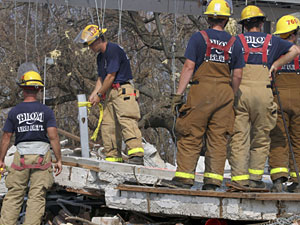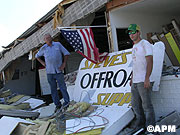 |
| Rescuer mark the location of a body found in Biloxi during a search on Saturday. (Photo by Ross Taylor/Getty Images) |
New Orleans — (AP) Thousands more bedraggled refugees were bused to salvation Saturday, leaving the city of New Orleans to the dead and dying, the elderly and frail stranded too many days without food, water or medical care.
No one knows how many were killed by Hurricane Katrina's floods and how many more succumbed waiting to be rescued. But the bodies are everywhere: hidden in attics, floating among the ruined city, crumpled on wheelchairs, abandoned on highways.
And the dying goes on - at the convention center and an airport triage center, where bodies were kept in a refrigerated truck.
Gov. Kathleen Blanco said Saturday that she expected the death toll to reach the thousands. And Craig Vanderwagen, rear admiral of the U.S. Public Health Service, said one morgue alone, at a St. Gabriel prison, expected 1,000 to 2,000 bodies.
Touring the airport triage center, Senate Majority Leader Bill Frist, R-Tenn., a physician, said "a lot more than eight to 10 people are dying a day."
Most were those too sick or weak to survive. But not all.
Charles Womack, a 30-year-old roofer, said he saw one man beaten to death and another commit suicide at the Superdome. Womack was beaten with a pipe and being treated at the airport triage center.
"One guy jumped off a balcony. I saw him do it. He was talking to a lady about it. He said it reminded him of the war and he couldn't leave," he said.
More than 50,000 people had been waiting for rescue for nearly a week at the Superdome and New Orleans Convention Center. Most were finally taken out by bus and helicopter on Saturday.
At the convention center, thousands of refugees dragged their meager belongings to buses, the mood more numb than jubilant. Yolando Sanders, who had been stuck at the convention center for five days, was among those who filed past corpses to reach the buses.
"Anyplace is better than here," she said.
"People are dying over there."
Nearby, a woman lay dead in a wheelchair on the front steps. A man was covered in a black drape with a dry line of blood ran to the gutter, where it had pooled. Another had lain on a chaise lounge for four days, his stocking feet peeking out from under a quilt.
By mid-afternoon, only pockets of stragglers remained in the streets around the convention center, and New Orleans paramedics began carting away the dead.
A once-vibrant city of 480,000 people, overtaken just days ago by floods, looting, rape and arson, was now an empty, sodden tomb.
The exact number of dead won't be known for some time. Survivors were still being plucked from roofs and shattered highways across the city.
"There are people in apartments and hotels that you didn't know were there," Army Brig. Gen. Mark Graham said.
The overwhelming majority of those stranded in the post-Katrina chaos were those without the resources to escape - and, overwhelmingly, they were black.
"The first few days were a natural disaster. The last four days were a man-made disaster," said Phillip Holt, 51, who was rescued from his home Saturday with his partner and three of their aging Chihuahuas. They left a fourth behind they couldn't grab in time.
Since Friday, more than 25,000 residents have been evacuated, Mike Brown, director of the Federal Emergency Management Agency, said at a briefing Saturday morning in Baton Rouge.
Thousands of people were at Louis Armstrong New Orleans International Airport, where officials turned a Delta Blue terminal into a triage unit. Officials said 3,000 to 5,000 people had been treated at the triage unit since the beginning of the storm, but fewer than 200 remain. Others throughout the airport awaited transport out of the city.
"In the beginning it was like trying to lasso an octopus. When we got here it was overwhelming," said Jake Jacoby, a physician helping run the center.
Airport director Roy Williams said about 30 people had died, some of them elderly and ill. The bodies were being kept in refrigerated trucks as a temporary morgue.
At the convention center, people stumbled toward the helicopters, dehydrated and nearly passing out from exhaustion. Many had to be carried by National Guard troops and police on stretchers. And some were being pushed up the street on office chairs and on dollies.
Nita LaGarde, 105, was pushed down the street in her wheelchair as her nurse's 5-year-old granddaughter, Tanisha Blevin, held her hand. The pair spent two days in an attic, two days on an interstate island and the last four days on the pavement in front of the convention center.
"They're good to see," LaGarde said, with remarkable gusto as she waited to be loaded onto a gray Marine helicopter. She said they were sent by God. "Whatever He has for you, He'll take care of you. He'll sure take care of you."
LaGarde's nurse, Ernestine Dangerfield, 60, said LaGarde had not had a clean adult diaper in more than two days. "I just want to get somewhere where I can get her nice and clean," she said.
Around the corner, a motley fleet of luxury tour buses and yellow school buses lined up two deep to pick up some of the healthier refugees. National Guardsmen confiscated a gun, knives and letter openers from people before they got on the buses.
"It's been a long time coming," Derek Dabon, 29, said as he waited to pass through a guard checkpoint. "There's no way I'm coming back. To what? That don't make sense. I'm going to start a new life."
Hillary Snowton, 40, sat on the sidewalk outside with a piece of white sheet tied around his face like a bandanna as he stared at a body that had been lying on a chaise lounge for four days, its stocking feet peeking out from under a quilt.
"It's for the smell of the dead body," he said of the sheet. His brother-in-law, Octave Carter, 42, said it has been "every day, every morning, breakfast lunch and dinner looking at it."
When asked why he didn't move further away from the corpse, Carter replied, "it stinks everywhere, Blood."
Dan Craig, director of recovery at the Federal Emergency Management Agency, said it could take up to six months to get the water out of New Orleans, and the city would then need to dry out, which could take up to three more months.
A Saks Fifth Avenue store billowed smoke Saturday, as did rows of warehouses on the east bank of the Mississippi River, where corrugated roofs buckled and tiny explosions erupted. Gunfire - almost two dozen shots - broke out in the French Quarter overnight.
As the warehouse district burned, Ron Seitzer, 61, washed his dirty laundry in the even dirtier waters of the Mississippi River and said he didn't know how much longer he could stay without water or power, surrounded by looters.
"I've never even had a nightmare or a beautiful dream about this," he said as he watched the warehouses burn. "People are just not themselves."









